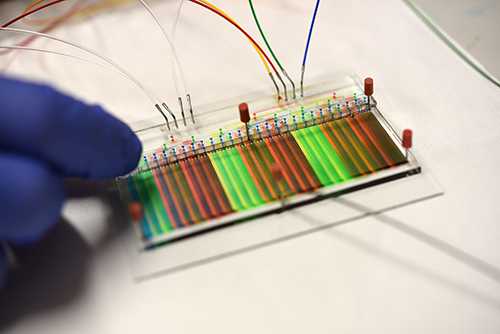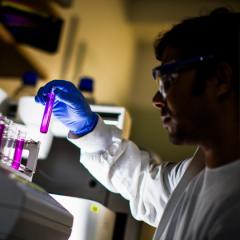For patients with kidney failure, the ability to replace a damaged kidney with a healthy kidney grown from their own cells could be a life saver. Now, scientists at the University of Queensland’s Australian Institute for Bioengineering and Nanotechnology (AIBN) have developed a remarkable new research tool that could help make this a reality.

The device is anticipated to substantially speed up the discovery of the biochemical signals that cause stem cells to become new kidney cells.
Stem cells have the potential to become any cell type in the human body. Everyone has a tiny population of stem cells in their body, but these ‘resident’ stem cells can be difficult to find, extract and use.
Fortunately, stem cell technologies have advanced profoundly in recent years, and it is now possible grow a population of stem cells from just a small swab of skin cells.
In order to then encourage these stem cells to give rise to kidney cells and ultimately a new kidney, researchers need to know precisely which biochemical signals — such as small molecules or larger molecules called growth factors — are needed and in what order. Unfortunately, this is currently unclear.
To complicate things further, there are almost 30 different types of kidney cells in the human kidney, all of which need to grow at the right time and location in order to function together as an organ.
Currently, the process of identifying the right biochemical signals for kidney development is time consuming and laborious, because it’s largely trial and error and involves enormous numbers of individual cell cultures.
To speed up this discovery process, UQ’s Professor Justin Cooper-White and his team at AIBN designed a ‘microfluidic’ device the size of a credit card.
As the name suggests, the device contains a multitude of microscopic fluid channels. Stem cells are placed in each of these tiny channels, making it possible to rapidly test different biomolecules on thousands of individual stem cells. Researchers can then analyse which ones encourage the formation of kidney cells.
The new device allows a level of analysis that wasn’t possible with previous technologies, explained Prof Cooper-White.
“The new technology provides a much faster, more accurate way of finding out which signals encourage human stem cells into different kidney cells,” he said.
The device can also be used to investigate how emerging kidney cells communicate with one another via their own chemical signals. This is important as evidence shows that cross-talk between cells plays a critical role in organ development.
The device could also be used to advance discoveries needed to grow other organs, as well.
The findings have been published in the journal Science Advances.


